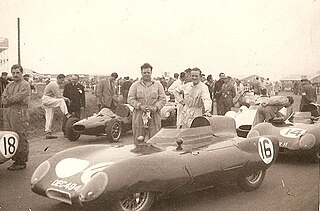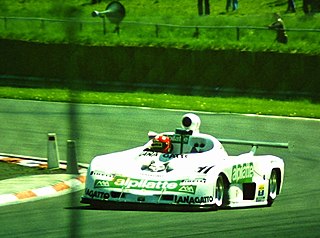Related Research Articles

Roy Francesco Salvadori was a British racing driver and team manager. He was born in Dovercourt, Essex, to parents of Italian descent. He graduated to Formula One by 1952 and competed regularly until 1962 for a succession of teams including Cooper, Vanwall, BRM, Aston Martin and Connaught. Also a competitor in other formulae, he won the 1959 24 Hours of Le Mans in an Aston Martin with co-driver Carroll Shelby.

The Mirage Lightweight Racing Car was a family of race cars built by J.W. Automotive Engineereing (JWAE) at Slough in England, initially to compete in international sports car races in the colours of the Gulf Oil Corporation.

Lotec is a German sports car manufacturer. The company was founded in 1962 by Kurt Lotterschmid. By 1969, the firm began building race cars, and would turn their attention to modifications for Porsches in 1975. In 1983, they began to create aftermarket aerodynamic and performance parts for Mercedes-Benz cars and Ferrari cars.

John Crosthwaite was an English race car designer and engineer, active in both the United Kingdom and the United States.

The Chevron B23 is a Group 6 sports prototype race car, designed, developed and built by British manufacturer Chevron, in 1973. Over its racing career, spanning 12 years, it won a total of 12 races, scored 41 podium finishes, and clinched 2 pole positions. It was powered by a naturally-aspirated 3.0 L (180 cu in) Ford-Cosworth DFV Formula One engine, producing 398 hp (297 kW).

The Lotus 69 was an open-wheel formula racing car developed by Lotus in 1969 for use in Formula 2, Formula 3, and Formula Ford.

The Ligier JS2 is a mid-engined sports coupé that was built by Ligier in the French commune of Abrest near Vichy in the department of Allier between 1971 and 1975. Road-going and competition versions were built.

The Osella PA3 is a Group 6 prototype racing car designed, developed, and built by Osella, to compete in the World Sportscar Championship sports car racing series in 1975, but was used in active competition through 1986. It was powered by a number of different engines, including the 2.0 L (120 cu in) BMW M12/7, the Abarth twin-cam engine, and the Cosworth BDG, or the 1.3 L (79 cu in) Cosworth BDH, or even the smaller the smaller 998 cc (60.9 cu in) Cosworth SCA. The 1.6 L (98 cu in) and 1.8 L (110 cu in) Cosworth FVA and Cosworth FVC were also used. It was even powered by a Ferrari 2.0 V8 engine.

The Osella PA5 is a Group 6 prototype racing car designed, developed, and built by Osella, to compete in the World Sportscar Championship sports car racing series between 1977 and 1981. It was powered by a number of different engines, including the 2.0 L (120 cu in) BMW M12/7, Hart 420R, and the Cosworth BDG. The 1.6 L (98 cu in) and 1.8 L (110 cu in) Cosworth FVA and Cosworth FVC were also used. It was even powered by a Ferrari 2.0 V8 engine.

The Osella PA6 and Osella PA7 are Group 6 prototype racing car designed, developed, and built by Osella, to compete in the World Sportscar Championship sports car racing series between 1978 and 1982. It was powered by a number of different engines, including the 2.0 L (120 cu in) BMW M12/7 and the Cosworth BDG, and the 1.6 L (98 cu in) Cosworth FVA was also used. After retiring from sports car racing, these cars later competed in hillclimb racing.

The Osella PA8 was a 2-liter, Group 6, sports car prototype, developed by Osella Squadra Corse in 1980, and used in sports car and Hillclimb races until 1988. It is powered by the naturally aspirated, 300 hp (220 kW), 2.0 L (120 cu in) BMW M12/7 engine, drives the rear wheels via a 5-speed Hewland LGA manual transmission.
The March 832 was a British open-wheel Formula 2 racing car, built by March Engineering in 1983. The car's best result in Formula 2 racing was third in the 1983 championship season with Beppe Gabbiani scoring 4 wins with Onyx Racing. After finding moderate success in open-wheel racing, it was later decided to convert the car to a closed-wheel sports prototype, for the revived Can-Am series, and compete in 1984. It was powered by the 2-liter BMW M12/7B engine. Kim Campbell successfully won the 2-liter Can-Am Championship that season, not scoring any wins, but managing to score 4 podiums, which was enough to clinch the championship.
The Cooper-MG is a series of two MG-powered sports cars that were designed, developed and built by Cooper Cars between 1950 and 1953. They were called the Cooper T14 and the Cooper T21, respectively. They actively competed in motor racing between 1950 and 1961. In that period, the MG-powered Coopers scored a total of 23 wins and 82 podium finishes between the two cars, and 2 pole positions. They were both power by the 1,250–1,500 cc (76–92 cu in) MG XPAG engine.

The March 721 is a Formula One car, designed, developed, and made by March Engineering for the 1972 Formula One season. It was powered by the 3.0 L (180 cu in) Ford-Cosworth DFV engine. It was driven by Ronnie Peterson, Niki Lauda, Henri Pescarolo, Carlos Pace, and Mike Beuttler.

The March 85G was a mid-engined IMSA racing sports prototype, designed and developed by March Engineering in 1984 and used in sports car racing until 1988.

The March 84G was a mid-engined Group C and IMSA racing sports prototype, designed and developed by March Engineering in 1983 and used in sports car racing until 1989. It was powered by a number of different engines, including a Chevrolet small-block, a Buick V6, a Porsche flat-six, and even a Mazda 13B Wankel rotary engine. Power output was around 620 hp (460 kW). It only managed to score 5 wins, and clinch a total of 10 podium, over the course of 7 years and 119 race entries.

The McLaren M22 is a open-wheel race car, designed and developed by McLaren, to compete in Formula 5000 racing in 1972. Like it predecessors, The McLaren M22 was manufactured in large numbers. Built close to the weight limit, it was very light and was powered by a 500+ hp Chevrolet V8 engine. The cars were not actually manufactured by McLaren itself, but by the British racing car manufacturer Trojan, as with previous models. This would turn out to be the last Trojan-built McLaren F5000 car.

The O.S.C.A. MT-4, also spelled the OSCA MT-4, or the Osca MT-4, is an Italian sports car prototype, designed, developed, and made by Officine Specializzata Costruzioni Automobili, between 1948 and 1956, but was raced and used in active competition until 1966. Between 1948 and 1966, it managed to rack up an incredible win tally of 92 wins, 109 class wins, 9 pole positions, and managed to clinch 194 podiums; an amazing record indeed.

The Cunningham C6-R was a sports car developed in 1952 for the Briggs Cunningham racing team. It won 10 races between 1952 and 1956, including 8 race wins in its class, and scored an impressive 16 podium finishes.
The Capoferri M1 was a Group 6 sports prototype race car, designed, developed and built by Renzo Zorzi, in 1979. It was closely based on, and took similar design cues from the similar Lola T286, which was also a racing prototype. It won a single race, at Enna-Pergusa, in 1980, where it also won in its class, and took pole position for the race. Similar to the Lola, it was powered by a 3.0 L (180 cu in) naturally-aspirated Ford-Cosworth DFV V8 engine, producing around 445 hp (332 kW) @ 10,500 rpm.
References
- ↑ "Bonhams : 1969-1970 Martin-Ford BDA BM 7 Racing Sports-Prototype Coupe Chassis no. BM7 Engine no. TBA". www.bonhams.com.
- ↑ "1970 Martin BM-8". conceptcarz.com.
- ↑ "1970 Martin BM-8 technical and mechanical specifications". conceptcarz.com.
- ↑ "Martin BM8" . Retrieved 28 June 2022.
- ↑ "Martin BM7" . Retrieved 28 June 2022.
- ↑ "Martin BM8" . Retrieved 28 June 2022.
- ↑ "Martin BM7" . Retrieved 28 June 2022.
- ↑ "Martin BM8" . Retrieved 28 June 2022.
- ↑ "Martin BM8" . Retrieved 28 June 2022.